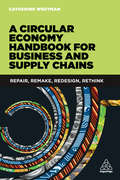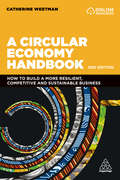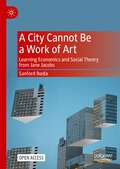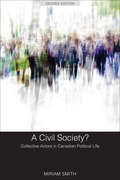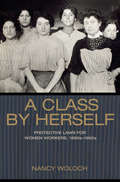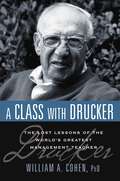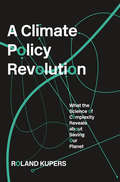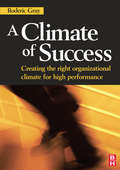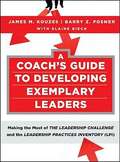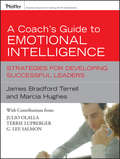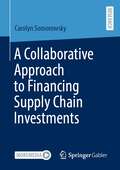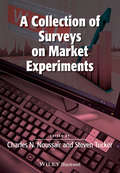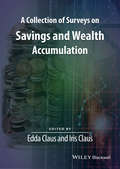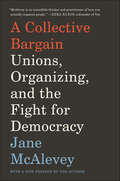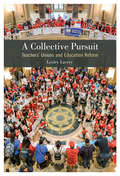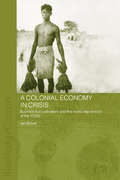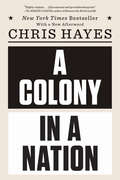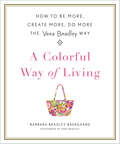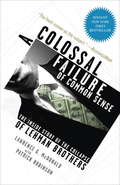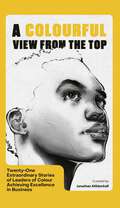- Table View
- List View
A Christian Approach to Corporate Religious Liberty (Palgrave Frontiers in Philosophy of Religion)
by Edward A. DavidThis book addresses one of the most urgent issues in contemporary American law—namely, the logic and limits of extending free exercise rights to corporate entities. Pointing to the polarization that surrounds disputes like Burwell v. Hobby Lobby, David argues that such cases need not involve pitting flesh-and-blood individuals against the rights of so-called “corporate moral persons.” Instead, David proposes that such disputes should be resolved by attending to the moral quality of group actions. This approach shifts attention away from polarizing rights-talk and towards the virtues required for thriving civic communities. More radically, however, this approach suggests that groups themselves should not be viewed as things or “persons” in the first instance, but rather as occasions of coordinated activity. Discerned in the writings of Saint Thomas Aquinas, this reconceptualization helps illuminate the moral stakes of a novel—and controversial—form of religious freedom.
A Chronology of Integrated Reporting
by Robert G. Eccles Michael P. KrzusThis technical note traces the development of integrated reporting through published materials, research, and the formation of various committees. Readers will gain an understanding of how the topics of nonfinancial information, sustainable development, corporate disclosure, and integrated reporting, among others, overlap.
A Circular Economy Handbook for Business and Supply Chains: Repair, Remake, Redesign, Rethink
by Catherine WeetmanA Circular Economy Handbook for Business and Supply Chains is an easily digestible and comprehensive handbook that provides a clear guide to the circular economy. Real examples across a range of market sectors help businesses, students and policymakers understand the theory and fast-developing practice of the circular economy. A holistic framework for the 'design and supply chain', business models and enablers helps generate ideas, and the book includes tools to help you get started. Whilst growing global consumption presents fantastic business opportunities, our current 'linear' systems - take some materials, make a product, use it and then throw it away - are not fit for purpose. The circular economy unlocks this problem by 'decoupling' resources from consumption. Switched-on businesses are re-thinking product design, material choices, business models and supply chains. A Circular Economy Handbook for Business and Supply Chains is a 'must-read' for anyone who wants to apply the circular economy today.
A Circular Economy Handbook: How to Build a More Resilient, Competitive and Sustainable Business
by Catherine WeetmanWINNER: 2018 Les Plumes des Achats & Supply Chain - The Committee Special Prize As we learn more about the climate and biodiversity crisis, it is clear that how we make and consume things is a major part of the problem. Extraction and processing of materials, fuels and food makes up about half of global greenhouse gas emissions and over 90% of biodiversity loss and water stress. Many modern businesses deplete resources, destroy ecosystems and dump waste and pollution at every stage - harming human health along the way. Governments, businesses and think-tanks see the circular economy as the way forward. Now in its second edition, A Circular Economy Handbook is a guided tour through the concepts and the practicalities. A unique framework systematically explores the range of circular interventions, including product and supply chain design, material choice and supporting business models. How does it really work for business? What circular approaches are emerging in food, fashion, consumer technology, packaging and other sectors? How do these reduce risk, improve resilience and build profitable, future-fit organizations? With over 300 real examples from around the world, this is a must-read for businesses, students and policymakers. This new edition has been extensively updated to include the latest trends, thinking, research and solutions, with a new chapter on packaging and 30 new company snapshots.
A City Cannot Be a Work of Art: Learning Economics and Social Theory From Jane Jacobs
by Sanford IkedaThis open access book connects Jane Jacobs's celebrated urban analysis to her ideas on economics and social theory. While Jacobs is a legend in the field of urbanism and famous for challenging and profoundly influencing urban planning and design, her theoretical contributions – although central to her criticisms of and proposals for public policy – are frequently overlooked even by her most enthusiastic admirers. This book argues that Jacobs’s insight that “a city cannot be a work of art” underlies both her ideas on planning and her understanding of economic development and social cooperation. It shows how the theory of the market process and Jacobs’s theory of urban processes are useful complements – an example of what economists and urbanists can learn from each other. This Jacobs-cum-market-process perspective offers new theoretical, historical, and policy analyses of cities, more realistic and coherent than standard accounts by either economists or urbanists.
A Civil Society?: Collective Actors in Canadian Political Life, Second Edition
by Miriam SmithA Civil Society? surveys the main approaches to the study of group politics in Canada, with a strong comparative perspective. Unique to this brief and accessible text is a comprehensive theoretical framework that helps students evaluate policy areas surveyed in the book, while also pointing them toward future study. This new edition opens with a discussion of power, political institutions, and identity. It goes on to explore group and social movement activity across a range of institutions including the House of Commons, the bureaucracy, and the courts as well as mobilization through social media and the electoral system. Throughout, Smith systematically integrates consideration of the role of gender, racialization, and indigeneity in contemporary Canadian group and movement politics.
A Class by Herself: Protective Laws for Women Workers, 1890s-1990s
by Nancy WolochA Class by Herself explores the historical role and influence of protective legislation for American women workers, both as a step toward modern labor standards and as a barrier to equal rights. Spanning the twentieth century, the book tracks the rise and fall of women-only state protective laws--such as maximum hour laws, minimum wage laws, and night work laws--from their roots in progressive reform through the passage of New Deal labor law to the feminist attack on single-sex protective laws in the 1960s and 1970s. Nancy Woloch considers the network of institutions that promoted women-only protective laws, such as the National Consumers' League and the federal Women's Bureau; the global context in which the laws arose; the challenges that proponents faced; the rationales they espoused; the opposition that evolved; the impact of protective laws in ever-changing circumstances; and their dismantling in the wake of Title VII of the Civil Rights Act of 1964. Above all, Woloch examines the constitutional conversation that the laws provoked--the debates that arose in the courts and in the women's movement. Protective laws set precedents that led to the Fair Labor Standards Act of 1938 and to current labor law; they also sustained a tradition of gendered law that abridged citizenship and impeded equality for much of the century. Drawing on decades of scholarship, institutional and legal records, and personal accounts, A Class by Herself sets forth a new narrative about the tensions inherent in women-only protective labor laws and their consequences.
A Class with Drucker: The Lost Lessons of the World's Greatest Management Teacher
by William CohenLong considered the world's greatest thinker and writer on management, Peter Drucker's teachings continue to inspire leaders everywhere. From 1975 to 1979, author William Cohen studied under the Great Man and became the first graduate of his doctoral program. What Drucker taught him literally changed his life. In a matter of a few years, he was recommissioned in the Air Force and rose to the rank of major general. Eventually, he became a full professor, management consultant, multibook author, and university president--as well as maintaining a nearly lifelong friendship with the master.In "A Class with Drucker", Cohen shares many of Drucker's teachings that never made it into his countless books and articles, ideas that were offered to his students in classroom or informal settings. Cohen expands on Drucker's lessons with personal anecdotes about his teacher's personality, lack of pretension, and interactions with students and others. He also shows how Drucker's ideas can be applied to the real-world challenges managers face today. Enlightening and intriguing, "A Class with Drucker" will enable anyone to gain from the timeless wisdom of the inspiring man himself.
A Climate Policy Revolution: What the Science of Complexity Reveals about Saving Our Planet
by Roland KupersHumanity’s best hope for confronting the looming climate crisis rests with the new science of complexity. The sheer complexity of climate change stops most solutions in their tracks. How do we give up fossil fuels when energy is connected to everything, from great-power contests to the value of your pension? Global economic growth depends on consumption, but that also produces the garbage now choking the oceans. To give up cars, coal, or meat would upend industries and entire ways of life. Faced with seemingly impossible tradeoffs, politicians dither and economists offer solutions at the margins, all while we flirt with the sixth extinction. That’s why humanity’s last best hope is the young science of complex systems. Quitting coal, making autonomous cars ubiquitous, ending the middle-class addiction to consumption: all necessary to head off climate catastrophe, all deemed fantasies by pundits and policymakers, and all plausible in a complex systems view. Roland Kupers shows how we have already broken the interwoven path dependencies that make fundamental change so daunting. Consider the mid-2000s, when, against all predictions, the United States rapidly switched from a reliance on coal primarily to natural gas. The change required targeted regulations, a few lone investors, independent researchers, and generous technology subsidies. But in a stunningly short period of time, shale oil nudged out coal, and carbon dioxide emissions dropped by 10 percent. Kupers shows how to replicate such patterns in order to improve transit, reduce plastics consumption, and temper the environmental impact of middle-class diets. Whether dissecting China’s Ecological Civilization or the United States’ Green New Deal, Kupers describes what’s folly, what’s possible, and which solutions just might work.
A Climate of Success
by Roderic GrayCould your organization be a better place to work? What effect would that have on the quality and quantity of what gets done?This book examines the concept of organizational climate ('what it feels like to work here') in a readable and accessible way without sacrificing academic rigour. Using case studies to illustrate the causes and consequences of various climate factors, it makes practical suggestions for how improvements can be made - to everyone's benefit.Building on current research, this book shows how perceptions of climate arise, the effects they can have on performance, and how managers can influence these perceptions and apply their understanding to improve their own and their people's effectiveness.
A Clinical Approach to the Dynamics of Leadership and Executive Transformation
by Elisabet Engellau Manfred F.R. Kets de VriesLike it or not, abnormal behavior is more "normal" than most people are prepared to admit; all of us have a neurotic side. Drawing on clinical data and psychoanalytical concepts, the authors of this chapter explore the following questions: Is the typical executive really a logical, dependable human being? Is management really a rational task performed by rational people according to sensible organizational objectives? They undertake a psychoanalytically informed investigation to discover how people and the organizations they work in really function, highlighting the importance of three triangles: the mental life triangle, the conflict triangle, and the relationships triangle. The chapter concludes with ideas about how to design and deliver a transformational leadership program within the context of a business school that encourages future executives to look into the original sources of their behavior and start the process of self-exploration. This chapter was originally published as Chapter 7 of "Handbook of Leadership Theory and Practice: A Harvard Business School Centennial Colloquium."
A Close Shave at Squire
by Michael Norris Jeffrey J. Bussgang William R. Kerr Benjamin N. Roth Zoe B. CullenIn 2020, just after closing a $34 million Series B financing round, Dave Salvant and Songe LaRon consider how to adjust their business, Squire Technologies, to the new realities posed by the COVID-19 pandemic. Their barbershop technology, including tools to run a shop and a mobile app for customers was growing swiftly, but with nearly all barbershops shut down to prevent the spread of the disease and no revenue coming in, should they cut back, or take the opportunity to build up?
A Coach's Guide to Developing Exemplary Leaders
by Elaine Biech James M. Kouzes Barry Z. PosnerKouzes' and Posner's bestselling The Leadership Challenge has been the most trusted source for becoming a better leader for millions of executives. This new guide from Kouzes and Posner, written in conjunction with coaching experts Elaine Biech, provides practical information and tools for integrating The Practices of Exemplary Leadership into a coaching practice or program. Filled with best practices and success stories as well as worksheets and checklists, this comprehensive resource enables coaches to quickly and easily adapt their coaching regimen to include The Leadership Challenge and the Leadership Practices Inventory (LPI).
A Coach's Guide to Emotional Intelligence
by James Bradford Terrell Marcia HughesA Coach?s Guide to Emotional Intelligence is a groundbreaking book that combines the topics of coaching and emotional intelligence in a down-to-earth resource for coaches, facilitators, and consultants. The authors, James Bradford Terrell and Marcia Hughes ?two experts in the field of emotional intelligence training?offer a number of elegant solutions that help coaches and their clients develop the authentic emotional skills needed to meet the challenges of today?s increasingly complex world. The book clearly shows how EI coaching can be applied within organizations and provides a solid coaching method for use with leaders in business settings. The book outlines five highly-effective strategies for developing influential leaders.
A Coincident Indicator of the Gulf Cooperation Council (GCC) Business Cycle
by Abdullah Al-HassanA report from the International Monetary Fund.
A Collaborative Approach to Financing Supply Chain Investments
by Carolyn SomorowskyCompetitive advantage is not achieved by a single company, but rather by the entire supply chain, with a focus on improving the flow of information, finance and goods. Improving these flows requires strategic investments relevant to the supply chain that are often long-term, capital-intensive, relationship-specific, and therefore risky. The past financial or COVID-19 crisis has made banks more risk averse, making it more expensive for supply chain members to finance risky investments or even more difficult to raise funds from external financial institutions. Supply chain finance is a young discipline that focuses on improving financial flows through a collaborative approach. Since most strategic investments are made by suppliers facing financial constraints, there is a high likelihood that supply chain disruptions will occur because the financing party becomes insolvent, or the investments do not materialize. To encourage strategic investments and avoid supply chain disruptions, a model is developed in which supply chain members leverage their financial and operational capabilities to realize these investments and share costs, risks, and benefits according to their contribution. The proposed model is based on a structured coalition game with transferable utility that determines the supply chain members best able to finance the investments without compromising supply chain stability.
A Collection of Surveys on Market Experiments (Surveys of Recent Research in Economics)
by Steven Tucker Charles N. NoussairComprised of 10 surveys by leading scholars, this collection showcases the largest and fastest growing strands of research on market behaviour in experimental economics. Covers topics such as asset markets, contests, environmental policy, frictions, general equilibrium, labour markets, multi-unit auctions, oligopoly markets, and prediction markets Focuses on the literature that has helped economists best understand how markets operate Assesses the impact of developments in theory, policy, and research methods
A Collection of Surveys on Savings and Wealth Accumulation (Surveys of Recent Research in Economics)
by Edda ClausIn this collection of critical surveys the reader is provided with a range of up-to-date work from some of the leading scholars in the area, writing on private and public sector aspects of savings and wealth accumulation. A survey of savings and wealth accumulation which are important dimensions of research and policy debates Discusses the measurement of genuine savings and sustainability, the estimation of wealth inequality, and recent developments in consumer credit and defaults Evaluates the impact of student loans on financial well-being, people’s retirement decisions, and the impact of pension reform Considers the distribution of wealth across generations and the importance of accurately measuring government debt, the rise of sovereign wealth funds and Islamic banking and finance
A Collective Bargain: Unions, Organizing, and the Fight for Democracy
by Jane McAleveyFrom longtime labor organizer Jane McAlevey, a vital call-to-arms in favor of unions, a key force capable of defending our democracyFor decades, racism, corporate greed, and a skewed political system have been eating away at the social and political fabric of the United States. Yet as McAlevey reminds us, there is one weapon whose effectiveness has been proven repeatedly throughout U.S. history: unions.In A Collective Bargain, longtime labor organizer, environmental activist, and political campaigner Jane McAlevey makes the case that unions are a key institution capable of taking effective action against today’s super-rich corporate class. Since the 1930s, when unions flourished under New Deal protections, corporations have waged a stealthy and ruthless war against the labor movement. And they’ve been winning.Until today. Because, as McAlevey shows, unions are making a comeback. Want to reverse the nation’s mounting wealth gap? Put an end to sexual harassment in the workplace? End racial disparities on the job? Negotiate climate justice? Bring back unions.As McAlevey travels from Pennsylvania hospitals, where nurses are building a new kind of patient-centered unionism, to Silicon Valley, where tech workers have turned to old-fashioned collective action, to the battle being waged by America’s teachers, readers have a ringside seat at the struggles that will shape our country—and our future.
A Collective Pursuit: Teachers' Unions and Education Reform
by Lesley LaveryTeachers’ unions are the organizations responsible for safeguarding the conditions of teachers’ employment. Union supporters claim strong synergies between teachers’ interests and students’ interests, but critics of unions insist that the stance of teachers in collective bargaining may disadvantage students as unions reduce the power of administrators to manage, remove, reward or retain excellent teachers. In A Collective Pursuit, Lesley Laveryunpacks how teachers’ unions today are fighting for contracts that allow them to earn a decent living and build “schools all students deserve.” She explains the form and function of the nation’s largest teachers’ unions. Lavery then explores unionization campaigns in the Twin Cities charter schools. A Collective Pursuit also examines teacher strikes and contract negotiations, school finance and finance reform, and district and union attempts to address racial achievement gaps, to provide a context for understanding the economic, political, and demographic forces that inspire teachers to improve conditions for students. A Collective Pursuit emphasizes that while teachers’ unions serve a traditional, economic role, they also provide a vast array of valuable services to students, educators, parents, and community members.
A Colonial Economy in Crisis: Burma's Rice Cultivators and the World Depression of the 1930s (Routledge Studies in the Modern History of Asia #Vol. 28)
by Ian BrownThe book challenges the orthodox argument that rural populations which abandoned self-sufficiency to become single commodity producers, and were supposedly very vulnerable to the commodity price collapse of the 1930s Depression, did not suffer as much as has been supposed. It shows how the effects of the depression were complicated, varying between regions, between different kinds of economic actors, and over time, and shows how the 'victims' of the depression were not passive, working imaginatively to mitigate their circumstances.
A Colony in a Nation
by Chris Hayes<P>New York Times best-selling author and Emmy Award–winning news anchor Chris Hayes argues that there are really two Americas: a Colony and a Nation. <P>America likes to tell itself that it inhabits a postracial world, yet nearly every empirical measure—wealth, unemployment, incarceration, school segregation—reveals that racial inequality has barely improved since 1968, when Richard Nixon became our first “law and order” president. With the clarity and originality that distinguished his prescient bestseller, Twilight of the Elites, Chris Hayes upends our national conversation on policing and democracy in a book of wide-ranging historical, social, and political analysis. <P>Hayes contends our country has fractured in two: the Colony and the Nation. In the Nation, we venerate the law. In the Colony, we obsess over order, fear trumps civil rights, and aggressive policing resembles occupation. A Colony in a Nation explains how a country founded on justice now looks like something uncomfortably close to a police state. How and why did Americans build a system where conditions in Ferguson and West Baltimore mirror those that sparked the American Revolution? <P>A Colony in a Nation examines the surge in crime that began in the 1960s and peaked in the 1990s, and the unprecedented decline that followed. Drawing on close-hand reporting at flashpoints of racial conflict, as well as deeply personal experiences with policing, Hayes explores cultural touchstones, from the influential “broken windows” theory to the “squeegee men” of late-1980s Manhattan, to show how fear causes us to make dangerous and unfortunate choices, both in our society and at the personal level. With great empathy, he seeks to understand the challenges of policing communities haunted by the omnipresent threat of guns. Most important, he shows that a more democratic and sympathetic justice system already exists—in a place we least suspect. <P>A Colony in a Nation is an essential book—searing and insightful—that will reframe our thinking about law and order in the years to come. <P><b>A New York Times Bestseller</b>
A Colorful Way of Living: How to Be More, Create More, Do More the Vera Bradley Way
by Barbara Bradley BaekgaardFrom the co-founder of the Vera Bradley empire, a practical and inspiring book that shows women how to awaken their full potential, at any age."This place could use some color!" That's what Barbara Bradley said to her friend Pat during an airport layover. It was 1982 and all the women could see was a succession of drab, bulky suitcases. When they returned home to Indiana, Barbara and her business partner got out a few Simplicity patterns and a Singer sewing machine and set to work. And the Vera Bradley Company was born.A Colorful Way of Living offers practical, inspiring advice to empower women of all ages to navigate life by the values that provide the foundation of the Vera Bradley empire. Women looking for the encouragement to start a new chapter, women balancing career and family, and new graduates entering the workforce will all benefit from the Baekgaard’s learned wisdom has as it applies to career, life, and relationships. Lessons include “Noticing Every Detail,” “Choosing Nice,” and “Remembering Always—there’s enough room for everyone.” In this highly readable book, Barbara Bradley Baekgaard shares the values that have helped her to thrive in business, health, and relationships--in every aspect of her personal and professional life.
A Colossal Failure of Common Sense: The Inside Story of the Collapse of Lehman Brothers
by Patrick Robinson Lawrence G. McDonaldOne of the biggest questions of the financial crisis has not been answered until now: What happened at Lehman Brothers and why was it allowed to fail, with aftershocks that rocked the global economy? In this news-making, often astonishing book, a former Lehman Brothers Vice President gives us the straight answers—right from the belly of the beast. In A Colossal Failure of Common Sense, Larry McDonald, a Wall Street insider, reveals, the culture and unspoken rules of the game like no book has ever done. The book is couched in the very human story of Larry McDonald&’s Horatio Alger-like rise from a Massachusetts &“gateway to nowhere&” housing project to the New York headquarters of Lehman Brothers, home of one of the world&’s toughest trading floors. We get a close-up view of the participants in the Lehman collapse, especially those who saw it coming with a helpless, angry certainty. We meet the Brahmins at the top, whose reckless, pedal-to-the-floor addiction to growth finally demolished the nation&’ s oldest investment bank. The Wall Street we encounter here is a ruthless place, where brilliance, arrogance, ambition, greed, capacity for relentless toil, and other human traits combine in a potent mix that sometimes fuels prosperity but occasionally destroys it. The full significance of the dissolution of Lehman Brothers remains to be measured. But this much is certain: it was a devastating blow to America&’s—and the world&’s—financial system. And it need not have happened. This is the story of why it did.
A Colourful View From the Top: Twenty-One Extraordinary Stories of Excellence in Business by Leaders of Colour
by Jonathan Mildenhall'Much needed inspiration for those working hard to reach a position that matches their potential and their allies' Ally Owen, Founder of Brixton Finishing SchoolYou might not think, right now, that you have what it takes to succeed. But incredible things do happen when you believe. We hope this book will stoke your sense of belief in what it is you can achieve and the gifts you have the potential to give to the world.Relentless in its inspiration, candour and warmth, A Colourful View From the Top is a vital anthology of twenty-one voices who are at the top of their game in business and beyond. Whether their specialism be advertising, tech, law or art, each luminary offers a unique and deeply meaningful collection of lessons and affirmations to draw upon time and time again.Discover how they became influential figures in culture and corporate life; how their achievements haven't been defined or limited by their race, gender or age; how sometimes the most fulfilling careers involve twists, turns and side hustles; how corporate success need not preclude social awareness.For too long, we have needed a more diverse set of commercial and cultural leaders to champion. Now it's time to hear their voices. Essential and engaging, A Colourful View From the Top is a deeply necessary compendium of varied experiences and career paths, candidly told by those who lived them.


